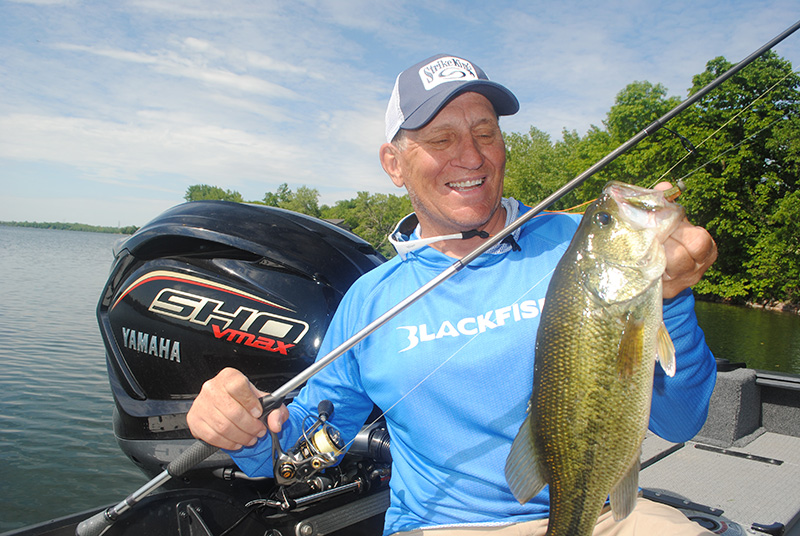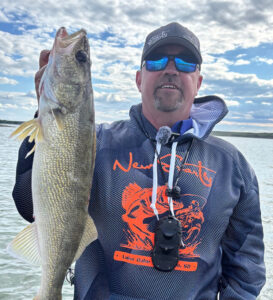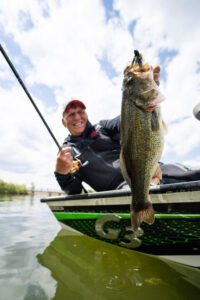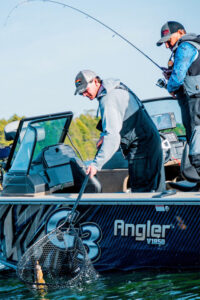By Mike Frisch
As a fishing TV show host and fishing educator, one of my “jobs” is to help people find and catch more fish. With that in mind, I am constantly researching and experimenting with cutting edge fishing techniques, staying on the lookout for the latest in technological gadgets, and keeping a watchful eye for good bites that materialize across the Midwest. This process has revealed some suggestions that I think can be useful for other anglers looking to “up their game” this fishing season.
See the fish, catch the fish!
For years, hardcore anglers, walleye anglers in particular, used their “down looking” sonar units to search for “marks” on those units’ screens that indicated what appeared to be walleyes below. When found, a marker buoy was pitched near the marks and the fishing began.
That process still works – though marker buoys have been replaced with electronic marks on a GPS screen. To really “be in the game” now, however, anglers need to take advantage of the various sonar technologies available that “look” forward, off to the sides, and around the boat. Many of today’s top tournament anglers, for example, are catching money-winning fish using these technologies. In fact, anglers who don’t use Forward Facing Sonar as it’s called in competitive fishing situations are often left in the dust.
I must admit that I am still learning this game but found it enlightening recently to “see” fish out away from my boat, pitch baits to them, and actually catch them at times! Simply put, the underwater world and its potential for producing fish is a lot bigger than what we used to see when we focused mostly on what was below the boat and ignoring, or maybe better said “not knowing,” what was ahead of and around the boat!
Fish the Ned Rig
Much of my bass fishing when guiding over the years involved throwing what were then called “jig-worms.” These were 4 to 7 inch plastic worm style baits threaded on light (often 1/16- to 1/8-ounce) jig heads. We’d slowly work down deep weed lines in good bass lakes casting and slowly working the baits along those weed edges. We’d catch bass, northern pike, and the occasional walleye.
Several years ago, however, smaller plastics fished on similar jigs came to the forefront, known as Ned Rigs. These baits are often in the 2 ½ to 3 inch size range making for a much smaller, more finesse style bait. And, they work! Clearer waters and increased bass fishing pressure on many lakes appear to be, in fact, ideal conditions for fishing them.
The past several summers a bunch of largemouth and smallmouth bass have fell victim to a plastic bait called a Ned Ocho fished on 1/8-ounce jigs by fishing partners and me.
If you like feeling the tug of a fish pulling back, a Ned Rig fished on the deep weed line will probably produce bass, northern pike, panfish, and maybe even a walleye or two!
Fish “smallies”
For whatever reason (I suspect clearer waters to be the cause), smallmouth bass populations have expanded and exploded in many lakes. That’s a good thing because smallmouth bass are extreme fighters and acrobats that are flat out fun to catch!
Mille Lacs Lake in central Minnesota has developed into one of the premier smallmouth lakes in the world. There are, however, expanding populations in a bunch of other lakes, both big and small, all across the Midwest. The good news is that a stop at a local bait shop may be all it takes to find lakes with good smallmouth fishing as it seems anglers are more willing to share details about their good smallmouth catches than they are to give up where the good walleyes are being caught, or details on big crappies!
Mike Frisch hosts the popular Fishing the Midwest TV series. Follow Fishing the Midwest on Facebook for more “fishy” information!
Photo – The author with a largemouth bass that ate a Ned Ocho.





